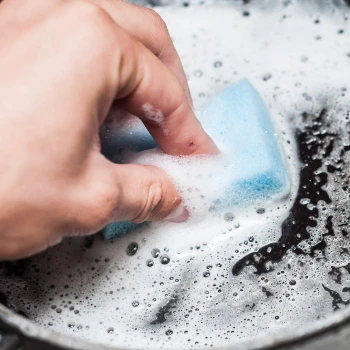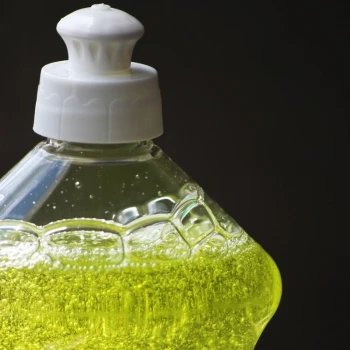
If you’ve ever had to wash a greasy pan, you’re familiar with dishwashing liquid’s remarkable grease-cutting power. But what exactly makes it so effective at this tough task?
In this article, we unveil the key property that makes dishwashing liquid detergent a powerful ally against a stubborn, greasy pan.
Let’s dive in.
Quick Summary
- Dishwashing liquid contains surfactants that reduce surface tension, enabling it to break down and emulsify grease and making it easier to wash grease and rinse away.
- Using hot water and pre-soaking dishes, especially for stubborn grease, can improve the effectiveness of dishwashing liquid.
- The US Food and Drug Administration advises using water at a temperature no lower than 110°F (43°C) to wash grease more effectively.
- Dishwashing liquids often include skin-friendly ingredients, making them safe for those who wash dishes by hand without the need for gloves.
The Science Behind Grease Removal

The secret behind dishwashing liquid’s magic lies in its surfactant properties, which give it the power to efficiently wash grease from greasy pans.
But what exactly are these surfactants, and how do they work?
The Role of Surfactants
Surfactants are compounds that lower the surface tension between two liquids, allowing them to mix.
In dishwashing liquid, these surfactants come in various types, each playing a different role, including:
- Improving wetting
- Degreasing
- Creating foam
- Enhancing functional properties
The surfactants interact with grease on a molecular level, breaking it down and making it easier to remove.
Specific surfactants commonly found in dishwashing liquid detergents include:
- Sodium Lauryl Sulfate (SLS): A widely used surfactant that creates a rich lather and effectively removes grease and oils.
- Sodium Laureth Sulfate (SLES): Similar to SLS, but slightly milder and also effective in breaking down grease.
- Cocamidopropyl Betaine: A milder surfactant derived from coconut oil that enhances foaming and grease-cutting properties.
- Alkyl Polyglucosides: Biodegradable surfactants derived from sugar and fatty alcohols that are effective in emulsifying grease.
These surfactants work together to break down and lift grease from surfaces, making it easier to wash away with water.
The Emulsification Process

The process of emulsification is where dishwashing liquid truly excels, breaking down oil on cookware into minuscule droplets that water can then easily carry off.
The detergent operates by encircling the grease, creating structures known as micelles that entrap oil and debris and facilitate their removal from the surface upon rinsing.
“Soaps are designed to attach to grease and fat molecules and help wash them away, and dish soaps are some of the strongest grease-fighters around.” – Caitlin Uttley, Author at HowStuffWorks
Temperature’s Role
Hot water enhances the cleaning action of dish soap by dissolving and activating the detergents with steam, softening and loosening grime and grease for easier dishwashing.
In fact, the US Food and Drug Administration recommends a hot water temperature of at least 110°F (43°C) for dishwashing.
Expert dishwashing tip: To effortlessly tackle greasy pans, let them soak in hot, sudsy water to soften the grease before washing for a smoother, more effective clean.
Maximizing Dishwashing Efficiency

Now that we’ve covered the basics, let’s move on to some advanced techniques that you can use to maximize your dishwashing efficiency.
Effective Application Methods
The way you apply your dishwashing liquid can make a significant difference in cleaning efficiency.
Here’s how to do it:
- Directly apply the dishwashing liquid to the surface of greasy pans.
- Distribute the detergent with a soft brush or sponge.
- Scrub the surface to effectively break down the grease.
Rinsing Techniques
To leave kitchenware spotless and safe, rinse thoroughly with warm water for a streak-free finish and let air dry to conserve energy and avoid heat damage.
Dosage Control
Use more dishwashing liquid for greasier pans or hard water, but avoid excess to prevent residue. See, less detergent may not remove all grease.
Step-by-Step Guide to Washing Greasy Pans

Here’s a step-by-step guide to washing greasy pans:
- Prepare Your Wash
Before washing, gather a scrub brush or sponge and dishwashing liquid. Clean the sink and fill it with hot water to dissolve the grease more effectively.
- The Washing Process
Start by scraping off excess food from the pan to make the dishwashing liquid more effective in targeting the grease.
Apply dishwashing liquid directly onto the pan and let it sit for a few minutes before scrubbing.
For stubborn, baked-on grease, consider a second application of dish soap and additional scrubbing.
- Aftercare for Your Pans
After cleaning, don’t forget to rinse the pan thoroughly with hot water to remove any soap residue and loosened grease.
FAQs
How Do Surfactants in Dish Soap Work To Remove Grease?
Surfactants in dish soap work by lowering the surface tension of water, allowing it to penetrate grease more effectively and breaking it down on a molecular level so that it can be rinsed away.
What Role Does Temperature Play in Washing Dishes?
Hot water helps dish soap clean dishes more effectively by activating the detergents and softening grime and grease, making it easier to wash grease away.
Did you enjoy this article? See Wynbert’s homepage for more information on how to keep your household pristine clean.
References:
